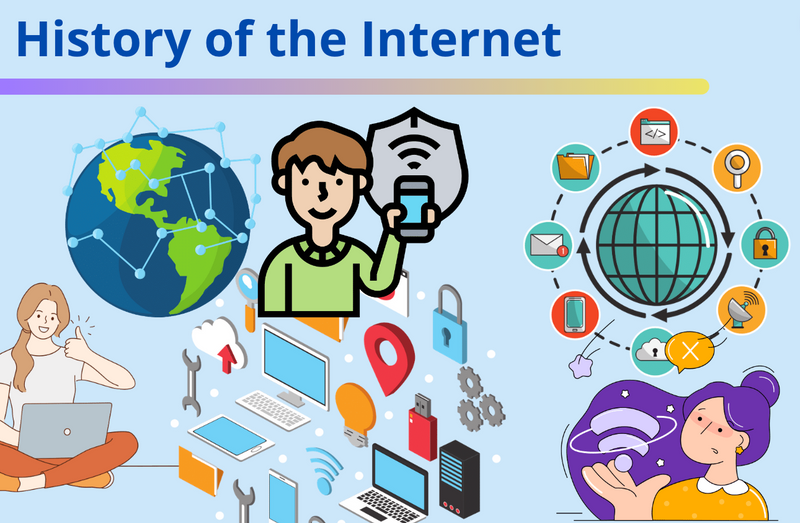The internet history is a long one, and it starts with efforts to develop computer networks. However, it has not always been easy. In fact, it is still a struggle to keep the internet running and safe. There are many hurdles to overcome, such as the Dot-com bubble and the Wide Area Information Server (WAIS). As we move forward, we should consider the history of the internet, and the various ways it is changing our lives today.
ARPANET
During the mid-sixties, computer networking was still in its infancy. Various research institutions and government agencies were creating networks for sharing information. One such network was called the ARPANET. This early computer network was designed to provide a secure information exchange for the U.S. Department of Defense.
The first successful host-to-host connection on the ARPANET was made by researchers at UCLA and Stanford Research Institute. Bill Duvall adjusted the machine’s parameters to allow Charley Kline, a graduate student at the University of California Los Angeles, to successfully type in the command “login” on the SRI’s mainframe.
After the two-character message was sent, the Stanford computer crashed. But, after the parameter was adjusted, Kline was able to successfully type in the letters “L” and “O”.
Then, Charley attempted to log in to the Stanford computer, but this failed as well. However, the first message was delivered on October 29, 1969.
This was one of many networking firsts that were achieved on the ARPANET. In fact, a number of the underlying internet technologies were developed on the ARPANET. These include data encryption, network email, and voice communication protocols.
Despite its success, the ARPANET was soon replaced by a new network. In 1990, the National Science Foundation Network (NSFNET) took over. It was a high-quality program that funded $200 million over five years, from 1986 to 1995.
Several universities joined the network, including the University of California, the University of Minnesota, and the University of Utah. Two more joined in Dec. 5, 1969, and in 1999, two more were added.
A new protocol for communications, TCP/IP, was developed on the ARPANET. Initially, the ARPANET hosted several other protocols, including NCP. Eventually, TCP/IP became the standard for Internet communications. By the end of 1990, TCP/IP had supplanted the majority of other wide-area computer network protocols.
Transmission Control Protocol (TCP)
TCP is a communication standard that breaks down information into small packets and ensures that all packets reach their destination. It’s used by the World Wide Web, email, streaming media, and file transfer protocols.
A three-way handshake is one way of ensuring that data is delivered reliably. This is one of the most important steps in Internet connection. The TCP protocol, along with the Internet Protocol, provides a means for computers to communicate over long distances.
TCP/IP is a protocol suite that is fully compatible with all operating systems. In fact, it was originally created for the Unix operating system. However, the protocol has been adapted to work with all OSes that came after Unix.
The Internet Engineering Task Force (IETF) maintains the TCP/IP model. It’s used in the Transport layer of the Internet Protocol suite.
The TCP/IP model was developed by the US Department of Defense in the early 1980s. It was intended to provide data communication service for the military. During its development, Vint Cerf and Bob Kahn drew on lessons learned from the Networking Control Protocol and the CYCLADES network.
The TCP/IP protocol has been upgraded over time. Today, it’s the standard protocol on the internet.
Although the original protocol was designed to be a reliable data delivery method, it has become prone to errors. As a result, TCP has been extended to handle data flows, control the size of data, and allow for the reassembling of packets at the receiving end.
TCP was first implemented on UNIX in 1977. In 1978, it was split into two protocols: Transmission Control Protocol and Internet Protocol.
Besides being a reliable way of delivering octets, the TCP has some other features. Among them is its synchronization of sequence numbers. When a connection is established, the server sends a sequence number to the client.
Internet Protocol (IP)
Internet Protocol (IP) is an essential component of the computer networking world. It is used for defining data exchange, as well as for governing the routing of datagrams on the Internet.
IP is also responsible for addressing host interfaces. Each device connected to the Internet has an IP address. These addresses are similar to phone numbers, and they are assigned to every device that uses the Internet.
The most important part of IP is the Internet layer, which ensures that data is delivered to the intended destination. There is no guarantee that the message will be delivered, and errors can happen. However, the Internet protocol does have its strengths.
TCP, a separate protocol, encapsulates data into packets. This allows data to flow from one end point to the other without interference. In addition, it keeps track of the order in which the packets arrive.
The smallest of the IP’s ilk, TCP, is able to deliver data to a predefined destination, and it does so reliably. Both TCP and IP rely on the other for the success of their respective functions.
IP and TCP are both core protocols of the Internet. The Transmission Control Program was a central control component. While the original IP circuit was a connectionless datagram service, the newer versions of the protocol allow for multicasting.
Aside from its ability to deliver data to a specified destination, TCP can also improve the security of an existing network. This is because it makes sure that all the machines in a system speak the same language, and that the machines operate correctly.
Likewise, the Internet Protocol may be prone to data corruption. Packets may not be in the right order, or they may be routed to the wrong destination.
Wide Area Information Server (WAIS)
The Wide Area Information Server (WAIS) is an electronic database service that enables you to search and browse through thousands of documents on the Internet. It allows you to find files related to specific topics, and then download them. You can do this by using the WAIS client.
To use the system, you need to install a WAIS client on your computer. There are many freely available clients for different operating systems. However, you need to be on an international TCP/IP network in order to use it.
A good place to start is the WAIS system document. This document includes a brief explanation of how the system works. In addition, it lists early WAIS resources.
The most common type of index is text. However, you can also index images and other forms of digital data.
Gopher is an electronic way to collect and organize information. You can search for information by looking through menus and using keywords.
One of the more impressive WAIS capabilities is the relevance feedback, which is the ability to determine which information is most relevant to your search. This is done by counting the number of times a document contains a particular word.
The World Wide Web has built-in possibilities for hypertext, but it requires a bit of human effort to select the most relevant information. The Internet is a great tool for collecting and analyzing information.
A WAIS client is not as complex as it sounds. Most can be installed on your computer. They are designed to work with libraries. If you are not familiar with the concept, you may want to ask for help.
Dot-com bubble
The dot-com bubble of the late 1990s and early 2000s was a major stock market boom and bust that shaped the internet and telecommunications industries. These companies raised a combined $1.6 trillion during the bubble.
This speculative bubble was fueled by investors’ FOMO and their desire to get in on the action. Investors believed that the United States economy had undergone a fundamental change, and that their investments could bring big returns.
But, despite these hyped expectations, most dot-com businesses did not make money. Some even went into liquidation.
During the dot-com bubble, investors were irrationally enthusiastic about the internet. They were convinced that the technology would transform the world.
Dot-com companies spent a lot of money on advertising. Analysts analyzed web traffic metrics without looking at the actual efficiency of online selling. Ultimately, investors overvalued dot-coms, and many of them crashed and burned.
Those who were able to profit from the dot-com boom made a fortune. As the companies went public, many employees were rewarded with stock options. At the time, most Internet startups had skyrocketing share prices. Moreover, they promised to change the world.
Conclusion
Eventually, the economy started to shrink and dot-com firms began to lose value. Those with the biggest market capitalizations were quickly wiped out. In addition, the Federal Reserve increased its overnight rate, making it harder to borrow money.
This led to a two-year bear market. NASDAQ had fallen 78% by the end of 2002. Its lows came during a recession, too.
Despite this, the overall number of users of the internet rose substantially. By 2010, it was estimated that there were 3.4 billion internet users.



